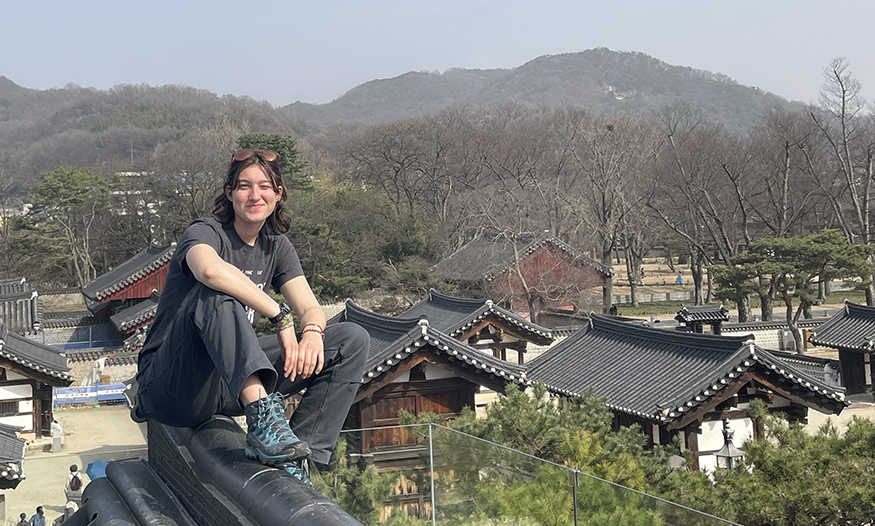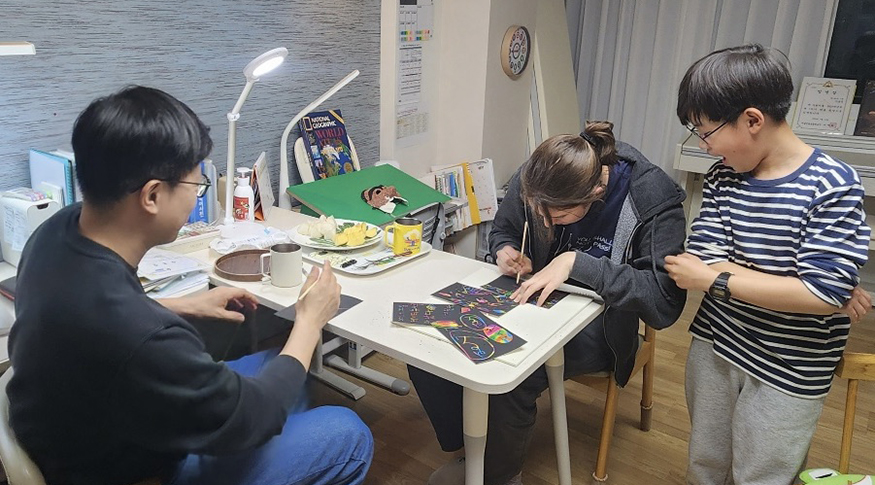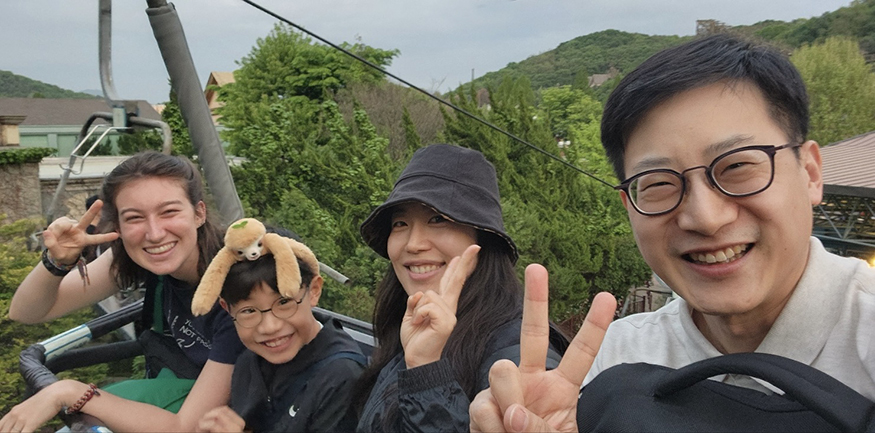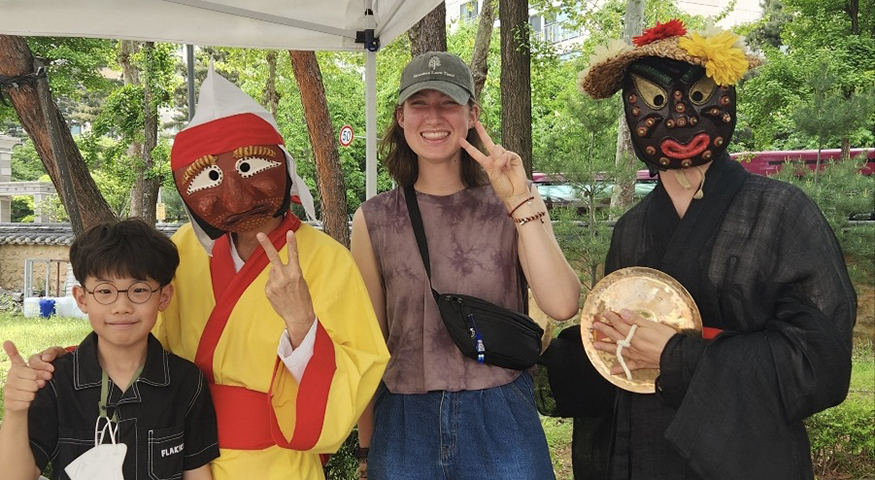Katie Ruesink is an undergraduate in the UW College of Arts & Sciences, majoring in Korean language and history and Middle Eastern languages and cultures. She spent the past academic year in Korea, taking courses at Seoul National University. In her own words, she shares how she made a special connection with a Korean family during her year abroad.

“Mom, this is a pineapple,” a little boy said in Korean, gleefully pointing at a plant. He and his mother were in front of me on the path of the Seoul Botanic Garden and traveling in the opposite direction. The plant was placed among other tropical species, close to a section about mangoes, but unadorned with an identifying tag. “No, it’s not a pineapple, I think it’s a different plant,” his mom responded as she adjusted his green Ralph Lauren adventuring backpack.
The boy was right. Although pineapples are unassuming and generally unexpected in their early growth stage compared to how we see them in the grocery store, the plant in question was in fact a pineapple — part of the bromeliad family, which are a highlight in tours I have led in the UW Biology Greenhouse over the past two years as a greenhouse assistant. So, even though usually I avoid small humans with their loudness and effusive feelings, I interjected: “네, 맞아요! 그거는 파인애플입니다! (Yes, that is a pineapple!)”

Mother and son were both very surprised I had addressed them, but quickly we got to talking. Where was I from? (Seattle, University of Washington.) What was I doing here? (Study abroad at Seoul National University.) What year of school was I in? (Third.) What was I studying? (Korean language and history and Middle Eastern languages and cultures at the UW.) How did I know that was a pineapple? (I had worked in a greenhouse.)
I learned that the boy’s name was Hojun, he was ten, and he was absolutely obsessed with plants and animals. Amazing. A kid I could connect with, finally. We exchanged contact information and continued on our way. I didn’t expect to ever see them again. The nerdy kid and kind mother would fade away into the distance like many other people I’d met while living in Seoul.
However, almost immediately we met again next to towering cacti, and we effortlessly spent the next few hours wandering together. I realized all my plant stories were in an English vocabulary I couldn’t translate particularly well, but we still had a great time exploring and laughing. This was the reason I was learning Korean, to randomly connect with people and share laughter. That’s the power of language. After we left the garden, Hojun’s mom bought us drinks before we parted ways.

A couple weeks later, I received an invitation to join their family for dinner. On a Friday after my Korean Law class, I got on Seoul’s trains for two hours in peak rush hour to meet them at Hongje station. It was raining, so we walked up to their Hyundai apartment complex in the classic melee of umbrellas and rushing people. In their small, clean, and homey apartment we had pizza with traditional side dishes. After meeting Hojun’s dad, I met Hojun's gecko and crab, which he keeps in his room, and we did art and ate apples for dessert. Hojun gave me a present of plant seeds, and a drawing on which he wrote, “For 누나 (older sister).” Thus I was ordained as a family member in writing.

Sometime later, we met at the Lotte Aquarium, the only place that Hojun can go see aquatic life in the city. When we sat down for a moment, his mom asked me some interesting questions: my MBTI (my personality type using the Myers-Briggs personality test), my blood type (older system of personality typing), and my IQ. MBTI is a huge deal in South Korea. It’s a very early question that people ask when you meet someone for the first time. Then Hojun called me over to see a lemon shark. He called “누나 오세요! (Older sister, come over here!)” Thus, I was ordained as a family member in speech.
The next time I saw the family was at a traditional arts festival partially hosted by Hojun’s grandfather, which included mask dances. I was taking a traditional Korean music class, so the impressiveness of this event was not lost on me. I was able to name the instruments and was familiar with some of the dances, which earned me some bonus points. I got to meet Hojun’s grandfather, an austere and rigid man with smiling eyes. Ten-year-old Hojun’s attention span meant we left the event for a while to walk around, look at bugs, and play with rocks in the surrounding park. When we returned to watch the finale, the audience was supposed to join right along, so at the behest of Hojun’s grandfather, I danced.

We had other adventures, including attending a baseball game and visiting Everland amusement park. The last time I saw the family, we went on a road trip to a farm in the middle of almost nowhere, for an immersive day-long farm experience geared toward kids ages 3-13. We dug potatoes in a prepared field, and then, at an enclosed section of a stream, caught fish with our bare hands. Everyone got really into it, plunging their hands into the water and attempting to kill the slippery trout. After an amazing lunch, we picked vegetables to be taken home. As we drove back to Seoul, Hojun showed me his ‘magic’ card tricks over and over, never tiring, until we said goodbye for the last time.
From an initial chance encounter at a botanic garden to experiencing life together however briefly, I became an older sister. Everything I did with Hojun and his family was something I wouldn’t have done otherwise, but even if we had just sat and talked, I would still have appreciated every moment. All of it was possible because of my Korean language ability, through all my many mistakes. Language connection is unfathomably powerful — one of the reasons I have chosen to study Korean and Arabic at the UW — and the acceptance from Hojun and his parents added a huge sense of belonging as a visiting student in such a bustling city.

More Stories

Need a break from holiday movies? Try these
For those wanting a break from holiday movies, Cinema & Media Studies faculty and grad students offer suggestions.

The Public Impact of Private Cities
Geography major Edwin Bai has researched private cities, developed by individuals and corporations, that "take the libertarian idea of low government regulation to the maximum."

Demystifying Quantum
In a physics course for non-STEM majors, Professor Miguel Morales teaches quantum mechanics without the advanced mathematics most quantum courses require.
